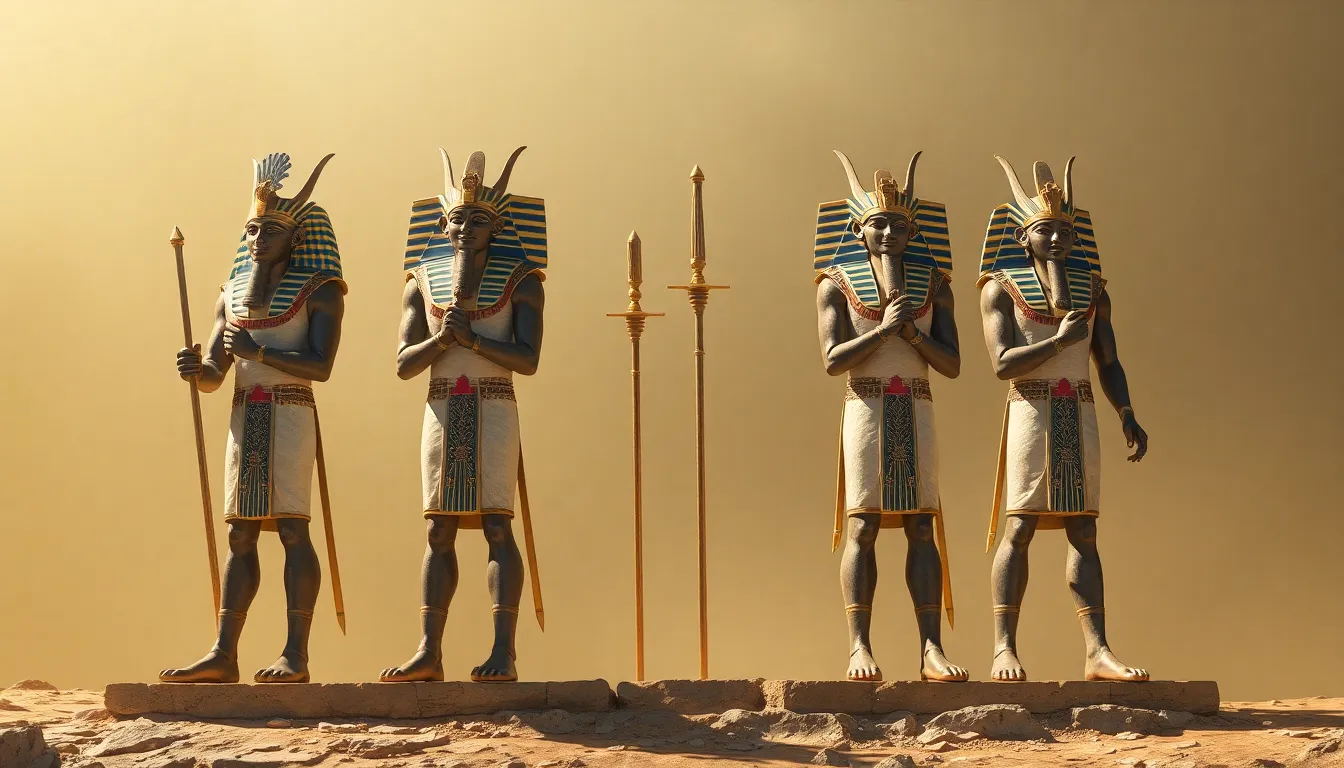The Four Sons of Horus: Protectors of the Afterlife
Introduction to the Four Sons of Horus
The Four Sons of Horus occupy a central place in ancient Egyptian mythology, symbolizing the vital protective forces that oversee the afterlife. Each son embodies a specific aspect of protection, ensuring that the deceased are safeguarded in their journey to the afterlife. The concept of protection in ancient Egypt was paramount, as it was believed that the journey after death was fraught with challenges and dangers that required divine guardianship.
Historical Context of the Four Sons
The origins of the Four Sons of Horus can be traced back to the rich tapestry of ancient Egyptian religion and mythology, where they emerged as key figures associated with the afterlife. Horus, the falcon-headed god, is a significant deity within the Egyptian pantheon, representing kingship and the sky. His sons, born from the union of Horus and the goddess Isis, were believed to serve as guardians of the deceased, particularly in the context of funerary rites and the protection of the body after death.
Individual Characteristics of the Sons
Each of the Four Sons of Horus possesses unique characteristics and attributes that define their roles in the afterlife:
- Imsety: The Human-headed son, Imsety is often associated with the human heart and represents the concept of emotional protection. He is known for safeguarding the liver of the deceased, which was considered essential for the afterlife judgment.
- Hapy: The Baboon-headed son, Hapy symbolizes fertility and the Nile. He protects the lungs of the deceased and is often depicted with a plump figure, representing abundance and vitality.
- Duamutef: The Jackal-headed son, Duamutef is connected to the protection of the stomach. His jackal form links him to the god Anubis, associated with mummification and the afterlife, emphasizing his role as a guardian of the deceased.
- Qebehsenuef: The Falcon-headed son, Qebehsenuef protects the intestines. His falcon form signifies his connection to the sky and the divine, portraying him as a lofty guardian watching over the deceased’s journey.
Symbolism and Attributes of Each Son
Each son is imbued with specific symbols and attributes that enhance their protective qualities:
- Imsety: Often depicted wearing a wig and holding a sistrum, Imsety symbolizes emotional strength and the heart’s importance in the afterlife.
- Hapy: His representation includes a baboon and often features him holding a sign of abundance, symbolizing his role in ensuring the deceased’s vitality.
- Duamutef: With a jackal head, Duamutef is frequently shown with various funerary utensils, emphasizing his protective role over the deceased’s physical remains.
- Qebehsenuef: He is depicted with a falcon head, often holding a knife, symbolizing his readiness to protect and defend the intestines of the deceased.
The Role of the Sons of Horus in Funerary Practices
The Four Sons of Horus played a crucial role in ancient Egyptian funerary practices. They were invoked during burial rituals, where their protective qualities were essential for the deceased’s safe passage to the afterlife. A significant aspect of their role involved the use of canopic jars, which were designed to hold and protect the vital organs removed during mummification. Each son was assigned a specific organ:
- Imsety: Liver
- Hapy: Lungs
- Duamutef: Stomach
- Qebehsenuef: Intestines
These jars were often crafted with the likeness of the respective son, serving as a physical embodiment of their protective powers. The jars were placed within a canopic chest, which was then sealed and buried with the deceased.
Artistic Representations and Iconography
The Four Sons of Horus have been depicted in various artistic forms throughout ancient Egyptian history. Their representations can be found in tomb paintings, sculptures, and artifacts, showcasing their significance in funerary art. Common themes include:
- Canopic jars adorned with their likenesses, often intricately designed with symbols of protection.
- Tomb paintings that illustrate scenes from the afterlife, where the sons are shown guarding the deceased.
- Sculptures and amulets featuring their forms, believed to offer protection to the living and the dead.
These artistic representations not only served a decorative purpose but also reinforced the belief in their protective capabilities in the afterlife.
The Four Sons of Horus in Modern Culture
The influence of the Four Sons of Horus extends beyond ancient times into modern culture. Their symbolism and protective qualities have been interpreted and represented in various forms of contemporary media:
- In literature, they appear in novels and scholarly works exploring Egyptian mythology.
- In film, their imagery has been used to depict ancient Egypt and its customs, often emphasizing their role as protectors.
- In popular culture, their symbols can be found in jewelry, tattoos, and art, reflecting an enduring fascination with ancient Egyptian beliefs.
Conclusion: The Legacy of the Four Sons of Horus
The Four Sons of Horus remain one of the most enduring symbols of protection within ancient Egyptian mythology. Their significance in safeguarding the deceased on their journey to the afterlife highlights the importance of protection in the beliefs of ancient Egyptians. As guardians of the vital organs and overseers of funerary practices, they underscore the spiritual and physical needs of the deceased, reflecting a deep understanding of life, death, and the afterlife. The legacy of the Four Sons continues to resonate today, reminding us of the profound ways in which ancient cultures sought to understand and protect the mysteries of existence.




